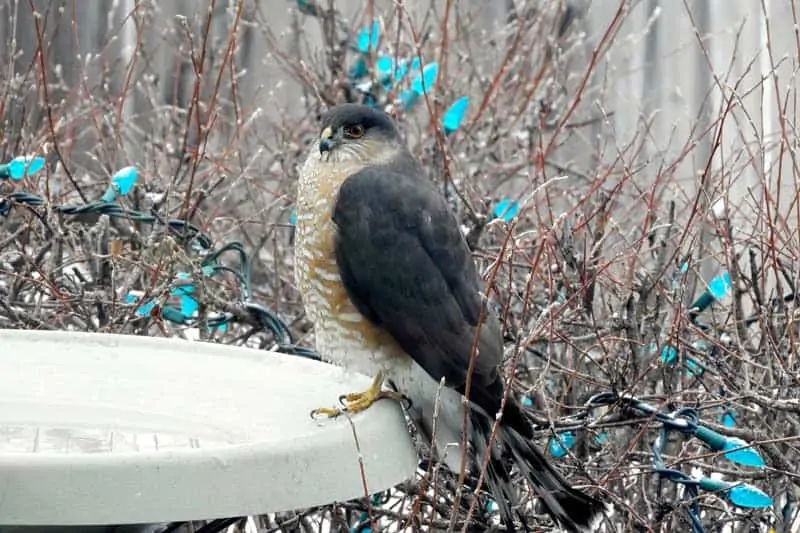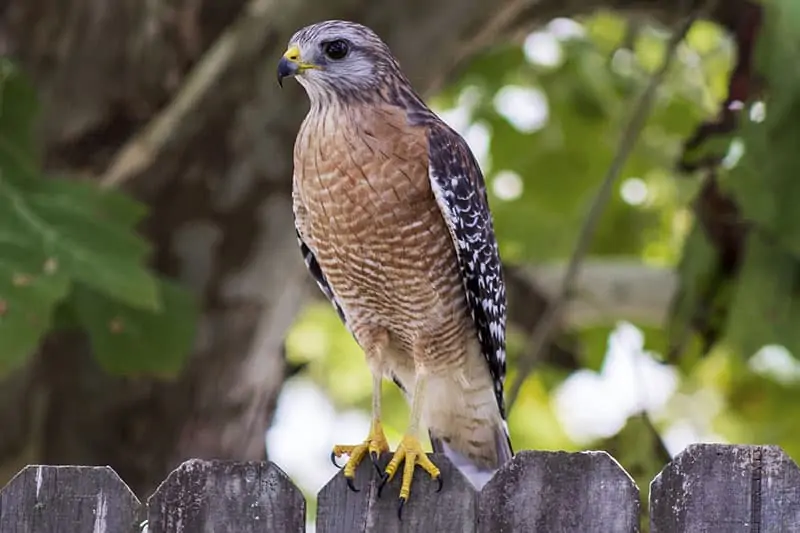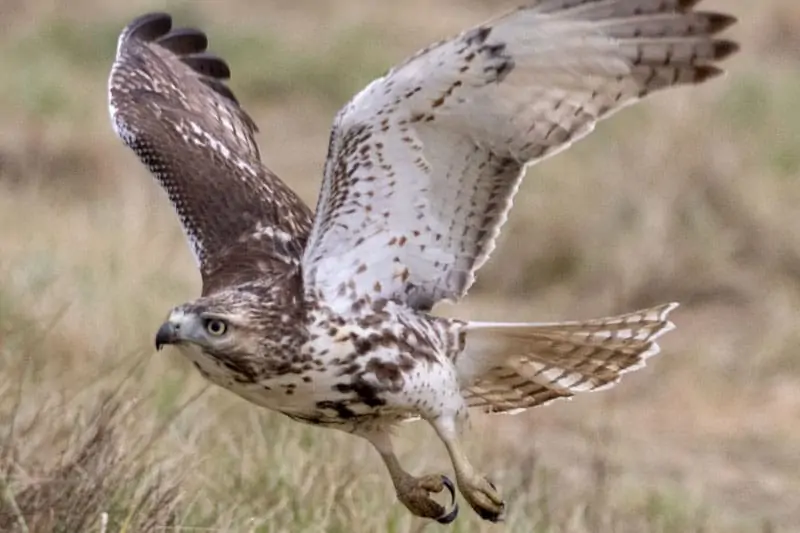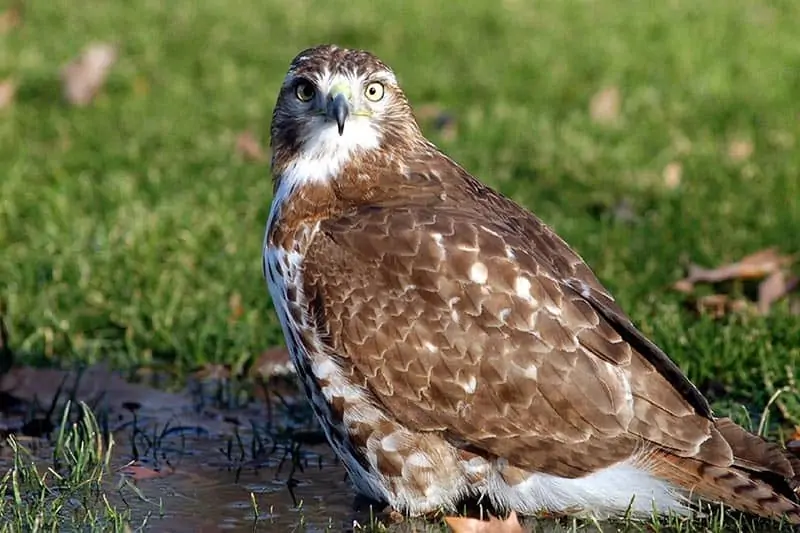We’ll provide you with a quick but useful description of the hawks in Arkansas in this article. Through the use of a few tools, you can become a better judge of who they are based on their looks, habits, and migratory patterns. We’ll also include a few interesting tidbits. When it comes to identifying Raptors, some people may be scratching their heads. When soaring high overhead, it’s difficult to get close to them, and they are just a variety of brown hues.
Unfortunately, this Arkansas hawk list will help to clear things up.
8 SPECIES OF HAWKS IN ARKANSAS
1. SHARP-SHINNED HAWK

Length: 9.4 – 13.4 in
Weight: 3.1 – 7.7 oz
Wingspan: 16.9 – 22.1 in
The smallest accipiters are sharp-shinned hawks, sometimes known as “sharpies.”
They have a hooded appearance because of their blue grey feathering on the back, nape, and crown. They have copper barring on their white underparts. Their eyes are startling red in color.
These quick and agile hawks are tiny and swift enough to sneak up on their victim or burst from a tree limb to pursue them, unlike some bigger hawks that swoop down on their victim from high above. They have been dubbed “pursuit hunters” as a result of this.
Sharpies will carry its meal back to a perch and de-feather it after performing their acrobatics through the trees and catching it with their catlike talons. They will frequently remove and eat the head of a catch that is for their mate or nestlings before giving the rest away.
In the winter, sharpies may be found in Arkansas. They may be observed hunting tiny birds and animals near forest borders during this non-breeding season.
Fun fact:
The Sharpie’s diet includes around 90% songbirds. This also gives them the ability to perform an crucial job of preserving natural bird populations in check and under control.
2. COOPER’S HAWK

Length: 14.6 – 15.3 in
Weight: 7.8 – 14.5 oz
Wingspan: 24.4 – 35.4 in
Cooper’s are larger overall, with a steely blue back and wings and reddish belly markings that are similar to the Sharpies in appearance. Because female hawks are bigger than males, it’s not uncommon for big female sharpies to differ from little male Cooper’s. The heads of Cooper’s Hawks are flatter, and their tails are rounded. These characteristics may help you distinguish the two.
In the bird world, Cooper’s hawks have some of the best fliers. They are formidable predators because of their power, which they use to hunt prey at breakneck speeds via the treetops. They can shoot through the treetops and pursue prey.
Cooper’s hawks are known for swooping down on backyard feeders, so don’t be surprised. Little birds focused on stuffing their bills as they sat out in the open. A silver platter is practically being fed to the hawks!
They prefer big species like doves, starlings, robins, jays, grouse, quail, and chickens over smaller birds.
Cooper’s Hawks may be found in both woodlands and urban settings throughout Arkansas year-round.
Fun fact:
These hawks may be aggressive. Cooper’s hawks squeeze their victim, much like other hawks do, but they have been observed taking it a step further and even drowning their victim.
In a examination of more than 300 Cooper’s Hawk skeletons, 23% presented healed-over breaks in the chest bones to further establish their rough inclinations.
3. RED-SHOULDERED HAWK

Length: 16.9 – 24.0 in
Weight: 17.1 – 27.3 oz
Wingspan: 37.0 – 43.7 in
The chestnut brown feathers on the wings of red-shouldered Hawks are marbled with bars on the breast, and they may be found year-round in Arkansas. The tail has strong bars and their pupils are completely black.
In damp deciduous woodlands, red-shouldered hawks survive. You may anticipate to see water, such as swamps, rivers, or marshes, if you spot this bird while out and about.
Red-shoulders, unlike other birds that feed on them, prefer non-feathered prey. Small animals, snakes, lizards, and amphibians are among the foods they consume.
Fun fact:
Great Horned Owls often prey on red-shouldered hawk nestlings. Great Horned Owls may be mobbed and chased off by these hawks and crows (who are also prey of the owl).
4. BROAD-WINGED HAWK

Length: 13.4 – 17.3 in
Weight: 9.3 – 19.8 oz
Wingspan: 31.9 – 39.4 in
The underbellies of these stocky birds are white with almond-colored stripes. Their backs are black, and their tails have thin white bars.
Broad-winged hawks eat a wide range of animals, including frogs, toads, and tiny rodents. Insects, reptiles, and other amphibians and mammals round out the rest of their diets.
Before heading back to South America for the winter, broad-wings spend their breeding season in Arkansas. They may be observed nesting in the vicinity of forest apertures and bodies of water while here.
Fun fact:
In making hawk-watching famous, this species played a crucial role. These birds, also known as “kettles,” are large migrating flocks that may contain thousands of birds. They’re a spectacular sight to observe. The birds in the kettle circle are similar to an invisible spoon stirring a cauldron in the sky.
5. RED-TAILED HAWK

Length: 17.7 – 25.6 in
Weight: 24.3 – 51.5 oz
Wingspan: 44.9 – 52.4 in
With their crimson tail against their brown skin above and white bellies below, this big hawk is quite easy to see. The belly of this species varies in streaking and markings, and there are various morphs of it. The belly band of the Eastern morph is well-defined, and its throat is white. It can be found in Arkansas.
The pinnacle of the ideal relationship is a red-tailed hawk couple. When they’re courting each other, they perform a cool sky dance, clasping talons and spinning to the ground. The red-tails then create a lifelong partnership and create their nest. They’ve also been spotted hunting in teams, with one individual climbing a tree to capture squirrels. Until one of the two dies, the pair will stay together.
These guys may be found in Arkansas year-round. During the winter, when immigrants from Canada come down to mix with the year-round population, sightings typically rise.
Fun fact:
The characteristic, raspy cry that raptors are known for is heard from Red-tailed Hawks. (Ahem, I’m referring to you, Bald Eagle.) It’s not always the cry of a Red-tailed Hawk that is used to represent the fierce birds of prey, as it is in the movies. As you read this, I’m betting that you can even hear it in your head!
6. NORTHERN HARRIER

Length: 18.1-19.7 in (46-50 cm)
Weight: 10.6-26.5 oz (300-750 g)
Wingspan: 40.2-46.5 in (102-118 cm)
The only harrier species native to North America is the Northern Harrier. It winters in more southern climes, such as Arkansas, and breeds as far north as Canada. In fields and marshes, they prefer to live and hunt.
Northern Harriers, like owls, use both their hearing and sight to catch prey, and they may drown it if they cannot subdue it. Although it is more customary for males to have just one or two female partners, they may have up to five at a time.
Fun fact:
In Arkansas and North America, Northern Harriers are the most owl-like hawks. To hunt for prey, they rely heavily on their acute hearing and vision.
7. NORTHERN GOSHAWK

Length: 20.9-25.2 in
Weight: 22.3-48.1 oz
Wingspan: 40.5-46.1 in
The northern half of Arkansas is only visited by Northern Goshawks on rare occasions. Northern Goshawks have rounded wings and long tails, like Sharp-shinned Hawks and Cooper’s Hawks. They are accipiters as well. Northern Goshawks, on the other hand, are the biggest accipiters in North America, far outstripping any of the other accipiters.
Northern Goshawks are hidden birds, much like the other accipiters we’ve discussed. These birds dwell in vast, thick woods and prefer to stay hidden, making locating them challenging. They are the most ubiquitous accipiter on the planet. The bright red eyes and bold white stripes that give Northern Goshawks the look of having eyebrows give them a predominantly gray plumage. Attila the Hun wore one on his helmet, and they’re typically seen as emblems of power.
Fun fact:
For almost 2000 years, falconers have utilized Northern Goshawks in hunting. Because of their exceptional skill at bringing in meat to cook, they were once referred to as “cooks hawks.”
8. ROUGH-LEGGED HAWK

Length: 18.5-20.5 in
Weight: 25.2-49.4 oz
Wingspan: 52.0-54.3 in
In Arkansas, Rough-legged Hawks are less common than other kinds of hawks, although they do have a breeding range that spans most of the state. They can be found in the open Arctic tundra throughout most of the year, as well as breeding. Yet, they migrate south in the autumn and spend the winter in most of the United States and southern Canada. They can be found in Arkansas throughout the winter, but they are more difficult to spot than other species. From year to year, their populations change dramatically, and depending on the abundance of lemmings, a major food source in the Arctic, their populations change dramatically.
The feathered legs of Rough-legged Hawks help them keep warm in the bitter north, giving them their name. These hawks are the only raptors in the United States with feathers along their legs and talons, in addition to Golden Eagles. With stocky bodies and long, broad wings, Rough-legged Hawks are large buteo hawks. While their tails are longer than most buteos, their feet and beaks are tiny.
Their tails fan out while they’re flying, and their wings are held in a “V” shape. Plumage in North America comes in a variety of colors, including light and dark morphs. White underparts and gray-brown uppers characterize adult light-morph males, while dark-morphs are usually dark brown all over with the exception of their underwings.
Fun fact:
The Rough-legged Hawk’s legs have feathers that extend all the way down to their feet, which is why the name “Rough-legged” refers to them. The only other North American raptors with these extra long leg feathers are the Ferruginous Hawk and the Golden Eagle.
